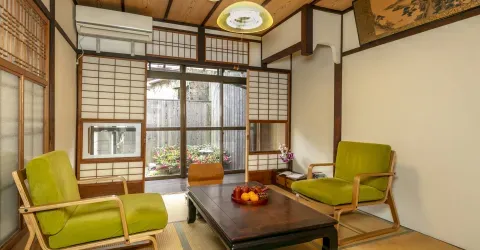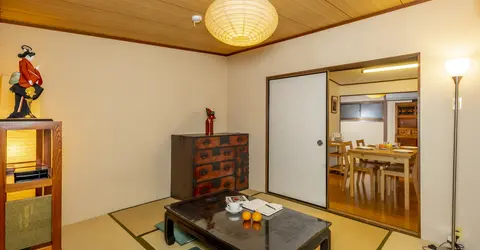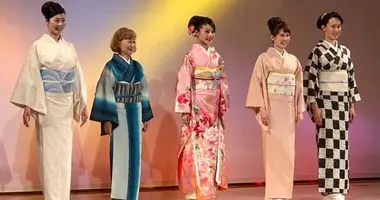Kawai Kanjiro Memorial Museum: A Journey Through the Life and Art of a Ceramic Master
- Published on : 05/06/2024
- by : Japan Experience
- Youtube

The house exterior, Kawai Kanjiro Memorial Museum, Kyoto, Japan
Nestled in the heart of Kyoto's Higashiyama district, the Kawai Kanjiro Memorial Museum offers a captivating glimpse into the life and work of one of Japan's most renowned potters. This former residence-turned-museum showcases the artistic legacy of Kawai Kanjiro, a pivotal figure in the mingei (folk art) movement. As you step through its wooden lattice entrance, you're transported to a world where art and daily life seamlessly intertwine. The museum houses an extensive collection of Kawai's ceramics, sculptures, and calligraphy, each piece reflecting his philosophy of beauty in simplicity. From the meticulously preserved living spaces to the impressive noborigama kiln, every corner of this museum tells a story of creativity and craftsmanship. Whether you're an art enthusiast or simply curious about Japanese culture, the Kawai Kanjiro Memorial Museum promises an enriching experience that will leave you inspired.
Introduction to Kawai Kanjiro and his artistic legacy
Kawai Kanjiro, born in 1890 in Shimane Prefecture, was a visionary artist who played a crucial role in shaping Japan's modern ceramic tradition. His journey into the world of pottery began at the age of 21 when he encountered the works of British potter Bernard Leach, an experience that would profoundly influence his artistic path. Kawai's artistic philosophy was deeply rooted in the mingei movement, which celebrated the beauty of everyday objects crafted by anonymous artisans. Throughout his career, Kawai produced a vast array of ceramics, sculptures, and calligraphy, all characterized by their unpretentious beauty and functional elegance.
What set Kawai apart from his contemporaries was his refusal to sign his works or accept official honors, including the prestigious title of Living National Treasure. He believed that "my work itself is my best signature," a testament to his humility and dedication to his craft. Kawai's legacy extends beyond his artistic output; he was also a prolific writer and philosopher, penning works that explored the intersection of art, life, and spirituality. The Kawai Kanjiro Memorial Museum, housed in his former residence and workshop, stands as a living tribute to this remarkable artist, offering visitors a unique opportunity to immerse themselves in the world of one of Japan's most influential Famous Japanese Artists.

Exploring the unique architecture and design of Kawai's home-turned-museum
The Kawai Kanjiro Memorial Museum is a testament to the artist's creative vision, seamlessly blending traditional Japanese architecture with Western influences. Built in 1937, the house was designed by Kawai himself, with the assistance of his carpenter brother. As you approach the museum, you're greeted by a façade that appears deceptively simple, with its wooden lattices reminiscent of countless other Kyoto townhouses. However, step inside, and you'll discover a space that is anything but ordinary.
The interior of the house is a harmonious fusion of Japanese and Western elements. Traditional features such as tatami mats, shoji sliding doors, and an open hearth (irori) coexist with Western-style furniture and an innovative open-plan layout. One of the most striking architectural features is the unique staircase, cleverly integrated into a wall of built-in wooden drawers. This ingenious design exemplifies Kawai's ability to merge functionality with aesthetic appeal. The house is arranged over two floors, with the ground floor serving as the main living and working area, while the upper floor houses more private spaces and guest rooms. Throughout the house, large windows and strategically placed openings create a dynamic interplay of light and shadow, enhancing the serene atmosphere and showcasing Kawai's keen understanding of space and ambiance.

Interior, Kawai Kanjiro Memorial Museum
The artistic treasures within: Kawai's ceramics, wood carvings, and calligraphy
The Kawai Kanjiro Memorial Museum houses an extensive collection of the artist's works, offering visitors a comprehensive overview of his artistic evolution and diverse talents. At the heart of the collection are Kawai's ceramics, which range from functional everyday items to more sculptural pieces. His pottery is characterized by its bold forms, vibrant glazes, and often unconventional decorations. Particularly noteworthy are his signature copper-red, iron-brown, and cobalt-blue glazes, which he perfected through years of experimentation.
Beyond ceramics, the museum showcases Kawai's talents in other artistic disciplines. His wood carvings, often depicting natural forms or abstract shapes, demonstrate his skill in working with different materials. The museum also features examples of Kawai's calligraphy, which he approached with the same artistic sensibility as his pottery. These pieces often incorporate his own poetry or philosophical musings, providing insight into his thoughts and beliefs. Throughout the house, you'll find fresh flowers arranged in Kawai's vases, a tradition maintained by the museum to honor his love of nature and his belief in the harmony between art and daily life. As you explore the collection, you'll gain a deeper appreciation for Kawai's artistic versatility and his commitment to infusing beauty into everyday objects.

Kawai Kanjiro Memorial Museum, Kyoto, Japan
The heart of creation: Kawai's studio and the impressive noborigama kiln
One of the most fascinating features of the Kawai Kanjiro Memorial Museum is the artist's preserved studio and the impressive noborigama kiln. The studio, located at the rear of the property, offers a glimpse into Kawai's creative process. Here, you can see his pottery wheel, tools, and workbenches, all maintained as if the artist had just stepped away for a moment. The space is filled with unfinished works and experimental pieces, providing insight into Kawai's methodical approach to his craft.
The crown jewel of the museum is undoubtedly the massive noborigama kiln, a type of climbing kiln traditionally used in Japanese pottery. Kawai's kiln is particularly impressive, featuring eight chambers that stretch up a gentle slope. This design allowed for different firing temperatures and atmospheres, resulting in a wide range of glaze effects. The kiln, which could reach temperatures of up to 1,350 degrees Celsius, was a communal resource shared with other local potters. Today, while no longer in use, it stands as a testament to the technical mastery required in traditional Japanese ceramics. Visitors can peer into the kiln's chambers, imagining the intense heat and anticipation that must have filled the air during firings. The presence of this kiln at Kawai's residence underscores the integration of his art with his daily life, a core principle of his artistic philosophy.

The traditional noborigama kiln, Kawai Kanjiro Memorial Museum

Kiln, Kawai Kanjiro Memorial Museum, Kyoto, Japan
The serene garden: A reflection of Kawai's connection to nature
The Kawai Kanjiro Memorial Museum's garden is a tranquil oasis that perfectly complements the artistic spirit of the house. This small but meticulously designed space reflects Kawai's deep connection to nature, a theme that resonates throughout his artistic work. The garden, visible from various points within the house, serves as a living canvas that changes with the seasons, offering visitors a different experience depending on the time of year.
The garden's layout is simple yet thoughtful, featuring a mix of traditional Japanese garden elements with Kawai's personal touch. Stone pathways wind through carefully placed rocks and pruned shrubs, creating a sense of natural harmony. Seasonal flowers and plants add splashes of color, while a small water feature provides a soothing ambient sound. From the house's windows and verandas, the garden acts as a series of framed views, much like a living painting. This integration of indoor and outdoor spaces was crucial to Kawai's philosophy of living in harmony with nature. The garden not only served as a source of inspiration for his art but also as a space for contemplation and relaxation. Today, it continues to offer visitors a moment of serenity amidst the urban bustle of Kyoto, inviting them to pause and reflect on the beauty of simplicity that was so central to Kawai's artistic vision.

Garden, Kawai Kanjiro Memorial Museum

The simple garden at the Kawai Kanjiro Memorial Museum
Practical information for visitors: Access, hours, and admission
The Kawai Kanjiro Memorial Museum is conveniently located in the Gojozaka area of Kyoto's Higashiyama district. To reach the museum, visitors can take a 10-minute walk from the Kiyomizu-Gojo Station on the Keihan Main Line. Alternatively, those using Kyoto buses can alight at the Kawai Kanjiro Kinenkan-mae bus stop, which is served by several routes including the Raku Bus #100.
The museum is open daily from 10:00 AM to 5:00 PM, with last entry at 4:30 PM. However, it's closed on Mondays (or the following day if Monday is a national holiday), as well as during the New Year period (December 29th to January 3rd) and for occasional maintenance. Admission fees are 900 yen for adults, 700 yen for high school and university students, and 300 yen for elementary and junior high school students. To fully appreciate the museum and its collection, it's recommended to allow at least an hour for your visit. For those interested in a deeper understanding of Kawai's life and work, English audio guides are available for a small additional fee. Remember to check the museum's official website for any updates on opening hours or special exhibitions before your visit. The intimate nature of the museum means it can get crowded during peak tourist seasons, so visiting earlier in the day or during weekdays is advisable for a more relaxed experience.
Nearby attractions and exploring the Higashiyama area
The Kawai Kanjiro Memorial Museum is ideally situated for exploring some of Kyoto's most iconic attractions. Just a short walk away is the famous Kiyomizudera Temple, known for its stunning wooden terrace and panoramic views of Kyoto. The charming streets of Ninen-zaka and Sannen-zaka, lined with traditional machiya houses, are also nearby, offering a glimpse into old Kyoto with their quaint shops and teahouses.
For those interested in further exploring Kyoto's rich cultural heritage, the Kyoto National Museum is within walking distance, housing an impressive collection of Japanese art and artifacts. The imposing Sanjusangen-do, famous for its 1001 statues of Kannon, is also nearby. For a unique historical site, consider visiting the Mimizuka, a monument with a somber history. After exploring these attractions, you might want to relax at one of the many traditional tea houses in the area or enjoy a meal at a local restaurant specializing in Kyoto cuisine. The Higashiyama district, with its blend of historical sites and modern amenities, offers a perfect backdrop for immersing yourself in Kyoto's rich cultural tapestry, making the Kawai Kanjiro Memorial Museum an excellent starting point for your exploration of this fascinating city.




























